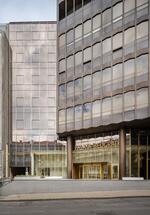In 1974, the Belgrade Palace was the tallest skyscraper in Belgrade. Built according to the most advanced architectural and construction standards, the "Beograđanka" could not escape the tradition of acquiring colorful, often derogatory nicknames, and soon received its own – "the Black Widow."
Architect Branko Pešić did not wish to engage in professional debates about the critiques of his work, believing he made the right choice in designing the "Beograđanka" exactly as it stands today. For over two decades, the architectural community ignored the building, with only historian and architectural theorist Zoran Manević recognizing its qualities at the time.
However, both professionals and the public initially failed to appreciate the architectural value of the "Beograđanka," which was only recognized decades later.
In addition to its architectural significance, the building gained cultural and historical value due to its façade design and the cultural and artistic institutions that were headquartered within it.
In recent years, opinions about the "Beograđanka" have taken a different turn, primarily because it was privatized, which many saw as taking the building away from the state, and therefore, the people—a perception viewed by some as problematic.
The building had deteriorated over the years, and there was no way to compel the state or city to invest the large funds necessary for its restoration. The fact that the building was under protection alone was insufficient; it also needed to be given a (new) function to preserve it.
For these reasons, privatization was the only way to save the building, and after a successful renovation, its operational life was significantly extended. The building was purchased by Marera Properties, which, after several successful partnerships on previous buildings, entrusted the reconstruction project to Remorker Architects.
Successful Reconstruction with a Subtle Personal Touch
The Remorker team understood that they faced a delicate task, yet saw plenty of opportunity to make this reconstruction more than just a replacement of worn-out elements. The goal was to give the entire building a new artistic expression that would meet all the functional needs of a modern office building.
The façade was completely preserved, with all window openings and glass replaced. Some of the windows were given the ability to open for natural ventilation. The old blinds, which hung visibly damaged and unevenly positioned on each window, were also preserved but were recessed for technical and aesthetic reasons.
The annex façade facing the Belgrade Waterworks building had to be changed, but the newly created structure was fully integrated into the existing façade rhythm of the main building. The entrance area, which had become neglected, needed a complete overhaul.
The newsstands and exchange offices that cluttered the entrance were removed, replaced with six-meter-high transparent display windows to allow for more light and create a seamless flow between the lobby's interior and the exterior plaza.
The entrance was also modified, with a brass-gilded portal installed instead of the small original entrance. Although this new design did not follow the original architectural expression, the patinated tone fit in well, adding emphasis and grandeur to the entrance.
The entrance area was flanked by white marble benches, which were also used as a primary material in the lobby interior, reinforcing the concept of blending interior and exterior spaces. The lobby, which was originally cramped, underwent the most significant interventions.
In addition to more extensive glazing and the use of white stone as the primary material to create a brighter ambiance, the gallery space was enclosed, and new furniture was introduced. This gave the lobby a fresh, refined expression, with artworks by renowned local artists once again adorning the space.
A typical floor, for example, also underwent significant changes. Narrow corridors and cramped offices were replaced by the now-standard open space, complete with a kitchenette, several private offices, smaller and larger conference rooms, and dedicated break and leisure areas.
A unique feature is that the top two floors were merged, with the upper floor transformed into a smaller gallery space. This new layout features a double-height ceiling, creating a truly impressive and unique atmosphere for a standard office space.
Special attention was given to the terraces on the 5th and 6th floors, which were completely redesigned into landscaped park areas, with shrubbery and wooden benches. The entire ambiance serves as a space for relaxation and break time for employees on these floors, as well as for organizing outdoor corporate events.
In reconstructing old buildings, it is essential to replace all elevators and systems, as every company renting office space expects a well-certified building that offers the amenities of a modern office. This includes plumbing, electrical, telephone, internet networks, heating, and air conditioning—all of which were long outdated in the "Beograđanka."
A Successful Example of Public-Private Partnership
As we can see, the renovation of the Belgrade Palace stands as a successful example of a public-private partnership, where an enlightened investor hires a skilled and creative architectural firm, harmonizing its design with the preservation department.
Knowing the past projects of Remorker Architects, there was no doubt that the cultural and historical value of the "Beograđanka" would be properly preserved, honoring the legacy of the renowned architect Branko Pešić.


